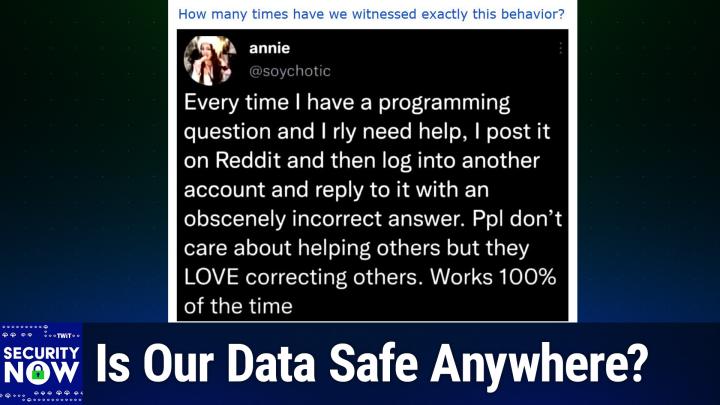
·E1036
Inside the SharePoint 0-day - Is Our Data Safe Anywhere?
Episode Transcript
Microsoft SharePoint Zero-Day Exploit
Jul 31st 2025
AI-created, human-reviewed.
The cybersecurity world was rocked by news of a devastating zero-day vulnerability in Microsoft SharePoint that has compromised hundreds of organizations worldwide, including critical U.S. government agencies. What makes this incident particularly alarming isn't just the scope of the damage, but how Microsoft's botched initial patch made the situation worse.
According to Security Now hosts Leo Laporte and Steve Gibson's recent analysis, over 400 organizations have been confirmed as victims of this SharePoint exploit, with the actual number potentially reaching into the thousands. Among the high-profile victims are several U.S. federal agencies, including the Department of Homeland Security, the National Nuclear Security Administration, and the National Institutes of Health.
The vulnerability affects on-premises SharePoint Server installations from 2016 and 2019, with an estimated 9,000+ vulnerable instances identified across the internet. Three Chinese Advanced Persistent Threat (APT) groups are believed to be behind the coordinated attacks.
What sets this incident apart from typical zero-day exploits is Microsoft's significant misstep in the patching process. The vulnerability was initially discovered at the Pwn2Own competition in Berlin in May, earning the researcher a $100,000 prize. However, when Microsoft released their patch on July 8th's Patch Tuesday, it was fundamentally flawed.
As Gibson explained in the podcast, Microsoft's initial fix was merely "cosmetic symptom covering" rather than addressing the underlying security weakness. Security researchers quickly identified that the patch could be easily bypassed, and within 24 hours, attackers were exploiting both unpatched AND supposedly "patched" systems.
"Microsoft fumbled and botched the security patch," Gibson noted, emphasizing how the company's rushed fix created a false sense of security while leaving organizations vulnerable.
The exploitation timeline reveals a coordinated and sophisticated campaign:
- July 7th: Initial limited attacks began (one day before the patch)
- July 8th: Microsoft releases flawed patches
- July 17th: First confirmed testing wave of attacks
- July 18th: Major attack wave begins, with iSecurity first reporting large-scale exploitation
- July 19th: Second major wave of attacks
- July 21st onwards: Multiple smaller waves after exploit code became publicly available
The most troubling aspect is that these attacks were effective against both unpatched systems and those that had applied Microsoft's initial "fix."
The attack method reveals a sophisticated understanding of SharePoint's architecture. Rather than deploying typical web shells, attackers used a subtle approach focused on extracting cryptographic secrets. The malicious code specifically targeted SharePoint's ASPNET machine keys, which are essential for generating valid authentication tokens.
Once these keys are stolen, attackers can essentially impersonate legitimate users indefinitely, turning any authenticated SharePoint request into a potential remote code execution opportunity. This makes the breach particularly dangerous because the compromise can persist even after patching.
Both hosts highlighted a critical industry-wide issue that this incident exemplifies. As Gibson put it, "The entire model that's evolved across our industry of selling online software systems that are later found to have critical vulnerabilities and expecting their users to suddenly take proactive responsibility... is inherently impractical and is badly broken in practice."
Microsoft is pushing customers toward their cloud-based SharePoint offerings while gradually ending support for on-premises versions. SharePoint Server 2016 and 2019 will reach end-of-support on July 14th, 2026, forcing organizations to either migrate to subscription-based cloud services or pay for extended support.
Leo Laporte noted the difficult position this puts IT administrators in: "The problem is it's working and it's been paid for... when budgets are tight and when are they not, going through all the hassle of switching to a paid Microsoft cloud-based service and then needing to continue paying for it can be a difficult sell to upper management."
For organizations running on-premises SharePoint, both hosts strongly emphasized that patching alone is insufficient. Critical steps include:
- Apply the latest corrective patches (not just the initial July 8th update)
- Rotate all SharePoint ASPNET machine keys - this is crucial as the attack specifically targets key exfiltration
- Restart IIS services on all SharePoint servers
- Assume compromise and conduct thorough security audits
- Consider disconnecting internet-facing SharePoint servers that have reached end-of-life
As one security researcher quoted in the discussion advised: "If you are running on-prem SharePoint, you should assume that you are compromised. You should not assume that you're not."
The severity of this incident is underscored by the unprecedented industry response, with security reports published by virtually every major cybersecurity vendor including Broadcom's Symantec, CISA, Cisco Talos, CrowdStrike, Palo Alto Networks, and many others.
This incident serves as a stark reminder of the challenges facing legacy software users and the critical importance of proper patch management. It also highlights the need for better industry practices around vulnerability disclosure and patch quality assurance.
This SharePoint zero-day represents more than just another security incident – it's a cautionary tale about the complex challenges of maintaining legacy systems in an increasingly hostile cyber environment. While Microsoft scrambled to fix their initial patch failure, the damage was already done to hundreds of organizations worldwide.
The incident underscores the urgent need for organizations to reassess their on-premises infrastructure and consider migration strategies, not just for security reasons, but for long-term viability. However, as the hosts noted, this shouldn't be seen as an endorsement of cloud-only approaches, which bring their own security challenges.
For cybersecurity professionals, this incident reinforces the importance of defense-in-depth strategies, assuming breach mentality, and the critical need for thorough testing of security patches before deployment.